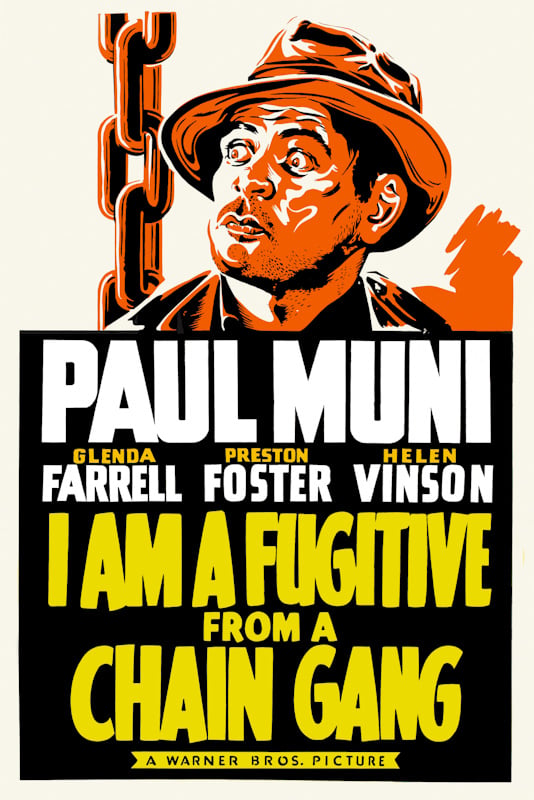A Great Escape: Fugitives and prison cruelty throughout cinematic history

The theatrical poster for the release of the 1932 film I Am a Fugitive From a Chain Gang. Image from Warner Bros., PD US no notice, via Wikimedia Commons.
I subscribe to quite a few news apps on my iPhone. I like to get my information regarding U.S. and world events from multiple sources, and feel that if I vary the input sources, there is less chance I’ll fall victim to the self-imposed echo chambers so many of us live in these days.
Don’t get me wrong: The constant flurry of notifications can cause a bit of a headache every now and then, but it really hits hard when something extraordinarily significant happens and every outlet, regardless of its spin, sees some benefit in reporting. Otherwise, it’s nice to receive varied views on various issues.
I recently received a push notification from Time regarding the 100 best movies of the last 10 decades. I was intrigued by the idea of scanning cinematic history and started from the beginning. It didn’t take long before I saw a title that caught my eye.
A crime-related movie I didn’t know about
Sitting there in the 1930s segment was a title I’d never heard of but found intriguing: I Am a Fugitive From a Chain Gang, released in 1932. I pride myself on being in the know when it comes to crime-related movies but didn’t give myself too much grief regarding my unfamiliarity—after all, most of this column’s focus is centered on recent media (created or released at least within the last 50 years, give or take). Seeing that this film was released almost 100 years ago, I didn’t feel too out of the loop.
I wanted to investigate before committing, so I did some digging to get a grip on the film’s background. To my extreme satisfaction, I learned that I Am a Fugitive From a Chain Gang is based on a true story.
World War I veteran Robert Elliott Burns penned the similarly titled book I Am a Fugitive from a Georgia Chain Gang to recount his time served on the chain gang from which he escaped. I haven’t read the book, but if the film is an accurate recount of the actual conditions preceding his escape, the process of fleeing the prison and the events that transpired afterward, then Burns’ story is outright incredible, to say the least.
According to the film, “James Allen” (the author’s character in the film) returns from his service in World War I with high hopes of starting a new career and life, only to be met with the reality that his dreams of working in construction and engineering won’t be as easy as he had hoped.
As he travels looking for work, he finds himself slipping into poverty to the point of scrounging for food. Allen meets another down-and-out person who promises him a hamburger from a local diner giving handouts, which leads to our protagonist finding himself at gunpoint being forced to aid in an armed robbery. Police quickly arrest Allen after arriving at the scene. Following a fly-by court scene in which a judge sentences him to hard labor, the audience is introduced to the dehumanizing conditions of a Southern state chain gang.
Allen eventually concocts a plan to escape with the help of another prisoner. He makes his way north to Chicago, where he assumes a new identity (not so cleverly calling himself “Allen James”) and begins to make good on his dreams of working in construction. Over the years, he progresses through the ranks to the point of being a well-respected member of society; however, due to a gripping twist of fate, Allen’s true identity is revealed, with the remainder of the movie showing just how cruel and wicked the criminal justice system can be when someone is stuck between a rock and a hard place (pun intended).
Prisoners treated cruelly
Usually, I’m not too hesitant to give away the plot of a film (with a spoiler warning, of course), but I’ll refrain here, as I truly hope my readers will give I Am a Fugitive From a Chain Gang a view for themselves. I’ve always been a reluctant fan of the Golden Age of Hollywood; there’s something special about the innocence those films portray. It can come off as corny and naïve at times, but the fact so many incredible movies were created during that age without having to rely on the shock value we see today is awe-inspiring.
But times change, and so do social norms. It’s entirely possible some matters depicted in early 20th-century celluloid that seem tame by today’s standards were taboo at the time.
I’ve previously detailed the psychological distress present-day inmates face at the hands of their custodians (Baby Shark, anyone?). Still, it seems clear from the conditions depicted in I Am a Fugitive From a Chain Gang that that era’s prison cruelty was likely even more severe than what incarcerated individuals face today. Nevertheless, the physical torment, whether intentionally inflicted or suffered as a result of deplorable conditions, is still accurate and highly problematic to this day.
Chain gangs, thankfully, fell out of favor and more or less disappeared by the late 1950s. Some states, though, such as Alabama and Arizona, reintroduced them in the 1990s. There needs to be more information available online regarding their current use, however. The last major article I could find regarding this punishment system was released by USA Today in 2013.
But the topic hasn’t escaped relatively recent scrutiny, at least to some degree. When I went about renting I Am a Fugitive From A Chain Gang on Amazon Prime, I came across the documentary American Chain Gang. I didn’t have the time to review it either (maybe you’ll see that in a future column), but the fact it was released in 1999, as was an article from The New Yorker in 2021, shows the discussion is alive and well.
Fugitives in other films
Movies often push a narrative that makes the fugitive somewhat sympathetic. Films like The Shawshank Redemption do their best to lean into this emotional aspect. Even those such as The Count of Monte Cristo, The Fugitive and Escape from Alcatraz—while offering nothing close to the emotional exhaustion of the aforementioned tear-jerker—still present a flawed protagonist the crowd is able to cheer for.
Interestingly, all four of the above-mentioned films also were initially based on written works. But whereas The Count of Monte Cristo and The Fugitive spend a good amount of time invested in the fugitive’s life outside of prison after his escape (much like I Am a Fugitive From a Chain Gang), The Shawshank Redemption and Escape from Alcatraz focus primarily on the turmoil of actually being behind bars and the planning that goes into the breakout.
These differing angles offer audiences the ability to empathize in different ways. After all, what’s worse: A life behind bars or gaining your freedom only to have it stripped away from you yet again? Some say one more day outside captivity is worth its weight in gold, while others might consider the metaphorical catch-and-release nothing more than a cruel joke. As they say, it’s all in the eye of the beholder.
Which perspective do you find more intriguing (the preescape story or the post-escape narrative)? Did I miss any of your favorite cinematic fugitives? Shoot me an email and let me know.
Until next time, take care and look out for and one another. The world’s an exceedingly crazy place.

Adam Banner
Adam R. Banner is the founder and lead attorney of the Oklahoma Legal Group, a criminal defense law firm in Oklahoma City. His practice focuses solely on state and federal criminal defense. He represents the accused against allegations of sex crimes, violent crimes, drug crimes and white-collar crimes.
The study of law isn’t for everyone, yet its practice and procedure seems to permeate pop culture at an increasing rate. This column is about the intersection of law and pop culture in an attempt to separate the real from the ridiculous.
This column reflects the opinions of the author and not necessarily the views of the ABA Journal—or the American Bar Association.



